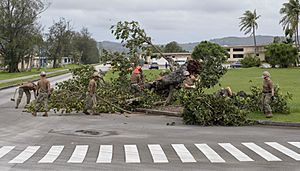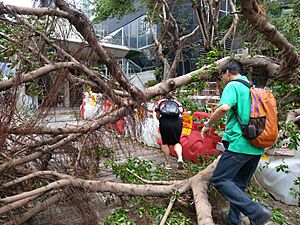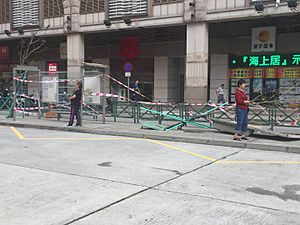Typhoon Mangkhut facts for kids

Typhoon Mangkhut at its peak intensity on September 12
|
|
| Meteorological history | |
|---|---|
| Formed | September 6, 2018 |
| Dissipated | September 17, 2018 |
| Unknown strength tropical cyclone | |
| 10-minute sustained (JMA) | |
| Highest winds | 205 km/h (125 mph) |
| Lowest pressure | 905 hPa (mbar); 26.72 inHg |
| Category 5 tropical cyclone | |
| 1-minute sustained (SSHWS/JTWC) | |
| Highest winds | 285 km/h (180 mph) |
| Lowest pressure | 896 hPa (mbar); 26.46 inHg |
| Overall effects | |
| Fatalities | 134 total |
| Damage | $3.77 billion (2018 USD) |
| Areas affected | Guam, Northern Mariana Islands, Philippines, Malaysia, Taiwan, Hong Kong, Macau, China, Vietnam, Japan |
|
Part of the 2018 Pacific typhoon season |
|
Typhoon Mangkhut, known in the Philippines as Typhoon Ompong, was an extremely powerful and damaging tropical cyclone in September 2018. It caused widespread destruction across Guam, the Philippines, and South China. This storm was one of the strongest typhoons to hit Luzon, a major island in the Philippines, since Megi in 2010. It was also the most intense typhoon to affect Hong Kong since Ellen in 1983.
Mangkhut means "mangosteen" in Thai. It was the ninth typhoon and fourth super typhoon of the 2018 Pacific typhoon season. The storm made landfall in Baggao, Cagayan, Philippines, on September 14 as a Category 5-equivalent super typhoon. It then moved on to impact Hong Kong and southern China. Overall, Mangkhut was the third-strongest tropical cyclone worldwide in 2018.
The typhoon left a trail of severe damage, costing about $3.77 billion (US dollars in 2018) across several countries. Sadly, at least 134 people lost their lives: 127 in the Philippines, six in mainland China, and one in Taiwan.
Contents
Understanding Typhoon Mangkhut
How Typhoon Mangkhut Formed
On September 5, 2018, a weather disturbance began to form near the International Date Line. Over the next few days, this system grew stronger. By September 6, it became a tropical depression. The Japan Meteorological Agency (JMA) officially classified it as a tropical depression on September 7. Soon after, it intensified into a tropical storm and received the name Mangkhut.
Over the next two days, Mangkhut quickly grew stronger. It developed a clear eye and strong spiral bands of clouds. Warm ocean waters and calm upper-level winds helped Mangkhut become very powerful. By September 9, it reached typhoon strength. A well-defined eye, about 18 km (11 mi) wide, was visible as the typhoon neared the Northern Mariana Islands and Guam. On September 10, it was considered a Category 2-equivalent typhoon with winds of 165 km/h (103 mph) as it passed near Rota.
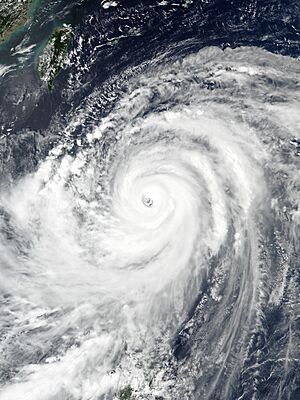
Mangkhut continued to strengthen significantly on September 11 as it moved across the Philippine Sea. It went through another period of rapid growth, forming a clear eye about 39 km (24 mi) wide. By September 12, it reached the highest category, Category 5, and stayed at this strength for almost four days. The typhoon's central pressure dropped very low, showing its extreme strength with winds of 205 km/h (125 mph).
The typhoon made landfall in Baggao, Cagayan, Philippines, at 2:00 a.m. on September 15 (Philippine time). At this point, it was a Category 5-equivalent super typhoon with winds of 260 km/h (160 mph). This made Mangkhut the strongest storm to hit the island of Luzon since Typhoon Megi in 2010. It was also the strongest nationwide since Typhoon Haiyan in 2013.
After crossing the mountains of Luzon, Mangkhut weakened before moving over the South China Sea on September 15. It made landfall again on the coast of Jiangmen, Guangdong, China, on September 16. The storm then quickly weakened as it moved westward. By late September 17, Mangkhut had completely faded away over Guangxi, China.
Getting Ready for the Storm
Philippines Prepares
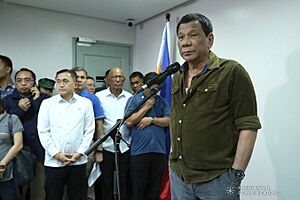
The Philippine Atmospheric, Geophysical and Astronomical Services Administration started issuing tropical cyclone warnings as early as September 13. People were asked or told to move to safer areas, especially in the Ilocos, Cagayan Valley, and Cordillera regions. These areas were expected to be hit hard by Mangkhut (Ompong).
Schools announced class suspensions starting September 12 to prepare for the typhoon. Medical and emergency teams were ready to help. By September 13, about ₱1,700,000,000 worth of relief goods were prepared.
| TCWS# | Luzon | Visayas | Mindanao |
|---|---|---|---|
| 4 | Ilocos Norte, Cagayan, Northern Isabela, Apayao, Kalinga, Babuyan Group of Islands | None | None |
| 3 | Batanes, Southern Isabela, Ilocos Sur, La Union, Mountain Province, Benguet, Ifugao, Nueva Vizcaya, Quirino, Northern Aurora | None | None |
| 2 | Pangasinan, Tarlac, Nueva Ecija, Southern Aurora, Zambales, Pampanga, Bulacan, Northern Quezon, Polillo Island | None | None |
| 1 | Bataan, Rizal, Metro Manila, Cavite, Batangas, Laguna, Rest of Quezon, Lubang Island, Marinduque, Camarines Norte, Camarines Sur, Catanduanes, Albay, Burias Island | None | None |
Hong Kong's Storm Alert
On September 12, as Mangkhut was expected to seriously threaten Hong Kong, the Hong Kong Government held a meeting with different government groups to plan their response.
On September 14, the Hong Kong Government held a rare press conference to prepare for Mangkhut, telling citizens to "prepare for the worst." That night, the Hong Kong Observatory issued the Standby Signal No. 1. This was issued when Mangkhut was 1,110 kilometres (600 nmi) away, the farthest distance on record for this warning.
On September 15, people living in low-lying areas like Tai O and Lei Yue Mun, which often flood during storms, were moved to safer places. The Hong Kong Observatory issued the Strong Wind Signal No. 3 in the afternoon.
On September 16, as Mangkhut continued towards the Pearl River Estuary, the Hong Kong Observatory issued the Gale or Storm Signal No. 8 during midnight. As local winds quickly grew stronger, the Increasing Gale or Storm Signal No. 9 was issued. At 9:40 a.m., the highest warning, Hurricane Signal No. 10, was issued. This was only the third time this warning had been issued since 1999. The signal stayed in place for ten hours, making it the second-longest duration ever.
Mainland China's Precautions
On September 15, most cities in Guangdong issued red alerts for Typhoon Mangkhut, which is the highest level of warning in the province. The Guangxi Meteorological Bureau also issued a red alert. The next day, Shenzhen issued a red alert for heavy rain.
The Fujian Meteorological Bureau issued an orange alert, the second-highest warning, on September 15.
On September 16, China's National Meteorological Center of CMA renewed a red alert for Mangkhut. The Hainan Meteorological Bureau issued an orange alert. In Guangzhou, the capital of Guangdong, schools, public transportation, and businesses were closed across the entire city for the first time since 1978.
The Civil Air Defense Office of Guangzhou Municipality cancelled the yearly air-raid drills planned for September 15. This was done to avoid causing panic as Typhoon Mangkhut approached. Schools in Beihai, Qinzhou, Fangchenggang, and Nanning were closed on September 17. Trains to Guangxi were also stopped on September 17.
The Impact of Mangkhut
Damage in Guam and Northern Mariana Islands
After the center of Mangkhut passed near Guam, about 80% of the island lost electricity. The typhoon caused $4.3 million in damage to buildings and roads in Guam.
Philippines: A Path of Destruction
After sweeping through Luzon, Mangkhut left a trail of destruction. Almost all buildings in Tuguegarao, the capital of Cagayan, suffered some kind of damage. The typhoon damaged roofs, knocked down trees, destroyed buildings, and blocked roads with debris. In a hotel in Santa Ana, shards of glass were blown through the corridors. In Manila, heavy rains caused widespread flooding in city areas. A tornado touched down in Marikina, eastern Metro Manila, on September 14, injuring two people.
Over 105,000 families moved from their homes. Several airports in northern Luzon closed, and airlines cancelled flights until September 16.
By September 22, police confirmed that the typhoon had caused at least 127 deaths. Eighty of these deaths happened when a small mine collapsed in Itogon, Benguet, where dozens of landslides buried homes. Philippine police also stated that 111 people were still missing as of September 22.
| Rank | Storm | Season | Damage | Ref. | |
|---|---|---|---|---|---|
| PHP | USD | ||||
| 1 | Yolanda (Haiyan) | 2013 | ₱95.5 billion | $2.2 billion | |
| 2 | Odette (Rai) | 2021 | ₱51.8 billion | $1.02 billion | |
| 3 | Pablo (Bopha) | 2012 | ₱43.2 billion | $1.06 billion | |
| 4 | Glenda (Rammasun) | 2014 | ₱38.6 billion | $771 million | |
| 5 | Ompong (Mangkhut) | 2018 | ₱33.9 billion | $627 million | |
| 6 | Pepeng (Parma) | 2009 | ₱27.3 billion | $581 million | |
| 7 | Ulysses (Vamco) | 2020 | ₱20.2 billion | $418 million | |
| 8 | Rolly (Goni) | 2020 | ₱20 billion | $369 million | |
| 9 | Paeng (Nalgae) | 2022 | ₱17.6 billion | $321 million | |
| 10 | Pedring (Nesat) | 2011 | ₱15.6 billion | $356 million | |
Francis Tolentino, an adviser to President Rodrigo Duterte, announced that an estimated 5.7 million people nationwide were impacted by the storm. Luzon suffered huge losses, which were more than double what was expected.
As of October 5, the NDRRMC estimated that Mangkhut caused PHP33.9 billion (US$626.8 million) in damage in the Philippines.
Effects in Malaysia and Taiwan
The outer winds from Mangkhut also affected some parts of Malaysia, including the state of Sabah.
In Yilan County, Taiwan, a thirty-year-old female teacher was swept out to sea by a wave while visiting Fenniaolin Beach. Her body was found two days later.
Hong Kong: Shattered Windows and Floods
Mangkhut was the most intense typhoon to strike Hong Kong since Typhoon Ellen in 1983. The highest typhoon warning signal, No. 10, stayed in place for ten hours. Winds of 81 km/h (50 mph) and gusts up to 169 km/h (105 mph) were recorded at the Hong Kong Observatory. On Cheung Chau island, these figures reached 157 km/h and 212 km/h (132 mph) respectively. The strongest winds near sea level were recorded at Waglan Island, with sustained winds of 180 km/h (110 mph) and gusts up to 220 km/h.
These strong winds caused many of the city's tall buildings to sway and broke glass windows. For example, the outer glass walls of the Harbour Grand Kowloon hotel were blown out. A part of a construction crane on a high-rise building in Tai Kok Tsui fell onto a nearby building, which had to be evacuated. Many roads were blocked by fallen trees and other debris, including main roads like Lockhart Road and Kam Sheung Road. Train services on the Mass Transit Railway (MTR) stopped on all above-ground sections of track.
Serious flooding was reported in many seaside areas, including Heng Fa Chuen, Tseung Kwan O South, Shek O, Lei Yue Mun, villages in Tuen Mun, and the fishing village of Tai O. This was due to a powerful storm surge (rising sea water pushed by the storm) of up to 3.38 metres (11.1 ft).
In Sai Kung, many yachts and boats sank. One boat was pushed by the storm and ended up on a pedestrian walkway. Seafront fences were destroyed by the powerful waves. A water treatment plant was also damaged.
About 1,219 people found safety in emergency shelters opened by the Home Affairs Department. The Hong Kong International Airport cancelled and delayed a total of 889 international flights. More than 200 people were injured, but thankfully, no lives were lost in Hong Kong. Because of the significant damage and disruption, the Education Bureau announced that all schools would be closed on September 17 and 18. Insurance companies in Hong Kong paid out about HK$7.3 billion (US$930 million) for damages.
The day after the storm, many people crowded the city's MTR train system. It ran fewer trains on some lines because parts of the tracks were blocked by debris. Most of the city's 600 bus routes also stopped working due to blocked roads.
Macau: Closures and Power Outages
A storm surge of up to 1.9 metres (6 ft 3 in) affected Macau. About 21,000 homes lost power, and 7,000 homes lost internet access. Forty people were injured. For the first time ever, all casinos in Macau were closed. The Macau International Airport cancelled 191 flights on September 15 and 16. Total damage in Macau was estimated to be 1.74 billion patacas (US$215 million). More than 5,500 people were moved to safer places.
Mainland China: Evacuations and Damage
Typhoon Mangkhut led to the evacuation of over 2.45 million people in mainland China. In Shenzhen, the storm caused power outages in thirteen locations, flooded Seafood Street, and knocked down 248 trees. Transportation was shut down in Southern China. At least four people in Guangdong lost their lives due to the typhoon. In Guangzhou, markets, schools, and public transport were closed or limited on Monday, September 17. Residents were asked to avoid unnecessary travel. Ferry services from Zhuhai's Jiuzhougang Port to Shenzhen and Hong Kong were stopped indefinitely.
In total, the storm caused six deaths and about CN¥13.68 billion (US$1.99 billion) in damage in mainland China.
Why the Name Mangkhut Was Retired
Because of the huge damage and many lives lost in Luzon, the PAGASA decided to remove the name Ompong from their list of typhoon names. This means Ompong will never be used again for a typhoon in the Philippine Area of Responsibility (PAR). The name Obet replaced it in 2019 and was first used in the 2022 season.
The name Mangkhut was also officially removed from the international list of typhoon names in February 2019. In July 2020, the Typhoon Committee chose Krathon as its replacement name.
See also
 In Spanish: Tifón Mangkhut para niños
In Spanish: Tifón Mangkhut para niños
- Weather of 2018
- Tropical cyclones in 2018
- Typhoons in the Philippines



